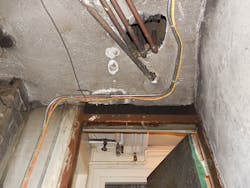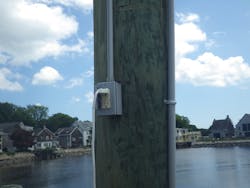How well do you know the Code? Think you can spot violations the original installer either ignored or couldn’t identify? Here's your chance to moonlight as an electrical inspector and second-guess someone else's work from the safety of your living room or office. Can you identify the specific Code violation(s) in this photo? Note: Submitted comments must include specific references from the 2023 NEC.
Hint: Follow the leader.
Tell Them What They've Won…
Using the 2023 NEC, correctly identify the Code violation(s) in this month's photo — in 200 words or less — and you could win an Arlington Industries 18-in. Slider Bar and plastic box for mounting between studs with non-standard spacing. E-mail your response, including your name and mailing address, to [email protected], and Russ will select three winners (excluding manufacturers and prior winners) at random from the correct submissions. Note that submissions without an address will not be eligible to win.
January Winners
Our winners this month were: Wayne Eckert, an EC&M reader from Clewiston, Fla.; Jason Andrews in Coquille, Ore.; and Juan García, a contest participant from Panorama City, Calif. Each was able to correctly cite some Code violations spotted in this photo.
For starters, the box cover was not designed to be installed to flip open to the left. It should have been installed with the cover flipping up. This type of cover is only weatherproof when closed. So, in this particular case, it’s not even the correct type of cover. For 15A or 20A, 125V or 250V receptacles installed in wet locations, Sec. 406.9(B)(1) requires enclosures to be weatherproof whether or not an attachment plug cap is plugged into the receptacle. Receptacles in wet locations must be listed and identified as weather-resistant (WR). If that GFCI receptacle gets damaged by water, the GFCI protection may fail to operate properly and leave users at an increased risk of shock. An extra-duty outlet box hood or some other weatherproof assembly could be used here.
About the Author

Russ LeBlanc
Owner
Russ started in the electrical trade as an apprentice in 1985. He worked his way up to become a Journeyman Electrician and then eventually became a Master Electrician and Licensed Construction Supervisor. In 1999 Russ become an Electrical Instructor for The Peterson School of Engineering in Massachusetts where he developed his passion for teaching, and quickly became Department Head of Electrical Instruction. Russ has taught thousands of apprentices, electricians, engineers, inspectors, and other electrical professionals during his career as an instructor. He continues to provide electrical professionals with Electrical Code seminars, Arc-Flash Awareness training seminars and educational material through his LeBlanc Consulting Services in North Reading, MA whose specialty is educating electricians. He has been an active member of the NFPA Electrical Section and has authored hundreds of National Electrical Code proposals and comments which have become Code rules to improve the safety for the electrical industry. Russ is also an IAEI certified Electrical Inspector.
Please visit www.russleblanc.net for more information.


